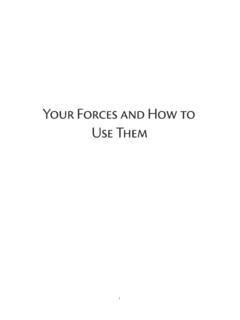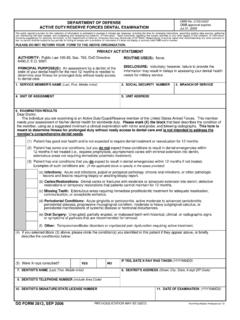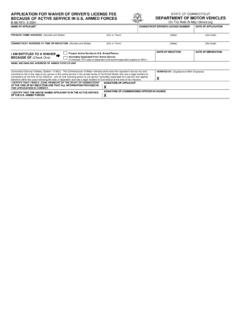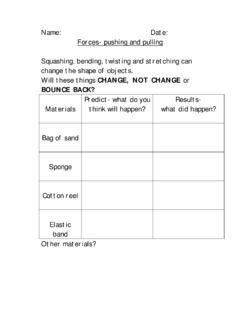Transcription of Science Grade 1 Forces and Motion
1 Science Grade 1 Forces and Motion Description: The students in this unit will use their inquiry skills to explore pushing, pulling, and gravity. They will also explore the different variables which affect the movement of objects, including weight, shape, surface resistance, and gravity. They will also explore how gravity aids in the movement of objects down a slope. Standards Aligned With This Unit CT State Science Standards: Content Standard: Forces and Motion What makes objects move the way they do? Expected Performances: A10. Describe how the Motion of objects can be changed by pushing and pulling. Grade Level Expectations (1st Grade ): Motion is caused by a push or a pull. A push or pull is called a force . Pushes and pulls can start Motion , stop Motion , speed it up, slow it down or change its direction. An object can be set in Motion by Forces that come from direct contact, moving air, magnets or by gravity pulling it down toward the earth.
2 Science Integration: Science Inquiry: Students in this unit will be experimenting with a variety of different materials to see the ways they move in response to force . They will be recording what they see and then organizing their data. They will also be making predictions and then using what they know to create models. Science Literacy: In this unit students will read fiction and non-fiction texts related to the unit. They should be encouraged to identify the main idea (A1 Literacy Standard) of the text, and to make connections (C1 Literacy Standard) with what they have learned about in class and other texts. The teacher can also question the students about why the author included specific sections in the book (B2 Literacy Standard). Science Numeracy: The students will be using math skills such as examine attributes of objects and describing the relationships (CT Math ), describing, naming and interpreting direction and position of objects (CT Math Standard ), collecting, organizing, recording and describing data (CT Math Standard ), organizing data in tables and graphs and making comparisons of the data (CT Math Standard ), and determining the likelihood of certain events through simple experiments and observations of games (CT Math Standard ).
3 Science CONTENT STANDARD CONCEPTUAL THEME: Forces and Motion - What makes objects move the way they do? CONTENT STANDARD: Grade -LEVEL CONCEPT 1: An object s position can be described by locating it relative to another object or the background Grade -LEVEL EXPECTATIONS: 1. An object s position can be described by comparing it to the position of another stationary object. One object can be in front of, behind, next to, inside of, above or below another object. 2. The description of an object s position from one observer s point of view may be different from that reported from a different observer s viewpoint. For example, a box of crayons between two students is near Susan s left hand but near John s right hand. 3. When an observer changes position, different words may be needed to describe an object s position. For example, when I am sitting on the bench the sun is behind me; when I move to the slide, the sun is in front of me.
4 4. The same object when viewed from close up appears larger than it does when viewed from far away (although the actual size of the object does not change.) For example, a beach ball held in one s arms appears larger than it does when viewed from across the playground. 5. An object s position can be described using words ( near the door ), numbers (10 centimeters away from the door) or labeled diagrams. Grade -LEVEL CONCEPT 2: An object s Motion can be described by tracing and measuring its position over time. Grade -LEVEL EXPECTATIONS: 1. Things move in many ways, such as spinning, rolling, sliding, bouncing, flying or sailing. 2. An object is in Motion when its position is changing. Because the sun s position changes relative to objects on Earth throughout the day, it appears to be moving across the sky. 3. Motion is caused by a push or a pull. A push or pull is called a force .
5 4. An object can be set in Motion by Forces that come from direct contact, moving air, magnets or by CMT EXPECTED PERFORMANCES A 10 Describe how the Motion of objects can be changed by pushing and pulling. gravity pulling it down toward the earth. 5. Pushes and pulls can start Motion , stop Motion , speed it up, slow it down or change its direction. KEY Science VOCABULARY: position, Motion , shadow, push, pull, force Unwrapped Conceptual Ideas: Pushing and Pulling are the ways that people and machines exert force . Shape has an effect on how objects move. Weight has an effect on how objects move. Resistance keeps an object from moving as far or as quickly. Gravity is a different type of force which pulls everything down to the earth. Unwrapped Major Skills: Student will be able identify objects they push and pull. Students will define force . Students will measure and record how different objects move.
6 Students will create models in which they apply the rules of movement they have learned. Common Misconceptions: Objects which are not in Motion have no force applied to them. The surface on which an object rolls does not affect its Motion . Instructional Strategies That Work: Letting students lead the discussion with the teacher acting as a guide, allowing students to experiment and then demonstrate their findings, providing students with a variety of materials to experiment with, allowing students to work together cooperatively, encouraging students to record data and use math skills to quantify data. Vocabulary Words: Push, pull, force , data, organize, Venn diagram, weight, shape, round, edge, surface, balanced, unequal, movement, gravity, earth, slope, flat Connections to Literature: Real Science 4 Kids, Rebecca Keller Eyewitness: force and Motion , Peter Lafferty Motion , Darlene Stille Experiments with Motion , Salvatore Tocci Move It!
7 Motion Forces And You, Adrienne Mason Overview of Lessons: Lesson One: What is Pushing and Pulling Lesson Two: What do we Push and Pull Lesson Three: Organizing our Data Lesson Four: Moving our Bodies Lesson Five: Weight, force , and Movement Lesson Six: Shape, force , and Movement Lesson Seven: Surface, force , and Movement Lesson Eight: Balanced and Unbalanced Forces Lesson Nine: Introduction to Gravity Lesson Ten: Gravity and Slopes Culminating Activity: Students will create a Motion station. In this setup and object of their choice moves the farthest with the least amount of force . This demonstrates their awareness of how shape, weight, surface, and gravity affect Motion . Lesson One: What makes things move? Student Goals: 1. Students will understand what pushing is. 2. Students will understand what pulling is. Vocabulary: push, pull, force Materials: computer with internet access, access to , projector you can hook up to monitor (if available) Procedure: 1.
8 Ask the students what they know about how things move. Discuss the different ways that things move (spin, twirl, roll, slide, etc.). Ask the students for specific examples of things they have seen, or even to get up in front of the class to demonstrate. 2. Explain to the student that although all things move in different ways, everything that moves is being either pushed or pulled. This is also known as force . Ask for a student to demonstrate pulling. See if they can name several things we pull every day (shoe laces, opening draws or doors). Then ask a student to demonstrate a push. Ask if they can name several things they push regularly (swings, pencil into pencil sharpener, etc.). 3. Tell the students that you will be watching a video designed to teach us a little bit about how different things move in different way as the result of pushing or pulling. 4. Go to and play the video titled How things Move.
9 Click on the link to play the video on a full-screen, and if available hook up the monitor to a projector for most visibility. 5. After the video review some of the main concepts with the students. Ask them to push a pencil across their desks, and then pull it back. 6. Have the students fill out their What is pushing and pulling? worksheet. Lesson Two: What do we push and pull? Student Goals: 1. Students will identify many objects in our daily lives that we push and pull. 2. Students will understand that if we did not exert force on these objects we would not be able to manipulate them. Materials: two differently colored packs of sticky notes, marker, one clipboard Procedure: 1. Review the previous lesson with the students. Ask them to define pushing and pulling. Ask them to tell you some of the things they push or pull often. 2. Tell the students they will be going on a push and pull scavenger hunt today.
10 Show the students the two differently colored sticky notes. Tell them that one color is going to stand for push, and one will stand for pull. Make sure to explain that there are several things which can be pushed or pulled, so it s ok if there is more then one color sticky note on an object. Tell them they can work in groups of three and go around the room. They can write the word push on one color sticky notes and attach it to any thing they push, and do the same for anything they pull with the other color notes. 3. Provide the students with enough time to label as many different things as possible. 4. After the students have returned review where all the notes have been placed. Some of the students can volunteer where they placed their notes and why they thought the note was appropriate. During this time the teacher should correct any misplaced notes. 5. Tell the whole class they did so well with that, you are going to go around the school and place appropriate labels around the building.











